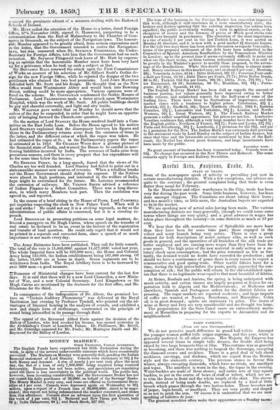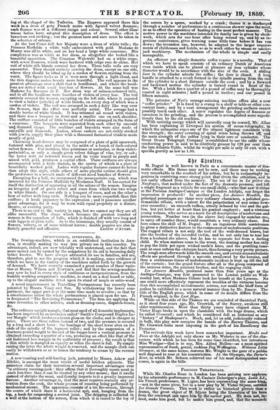FARIS FASHIONS.
(From our own Correspondent.)
We do not perceive much difference in grand ball toilets. Amongst the younger women puffed tulle reigns supreme, and this year, white is generally preferred to all other colours. Her Majesty the Empress has appeared several times in simple tulle dresses, the double skirt being raised by two large bouquets blue or lilac. This costume was as graceful as becoming, and there was nothing to bespeak the Sovereign, excepting the diamond crown and necklace. There is a gdod deal of talk about necklaces, ear-rings, and diadems, which are copied from the Morisco style and the sixteenth century. The precious stones in favour this winter, always excepting diamonds, which have no rivals, are amethyst and topaz. The amethyst is worn in the day, the topaz in the evening. Waist-buckles are made of these stones; and entire sets of tiny square buckles, to put in the centre of bows of stuff or velvet, which are use to trim the dress in front and the whole length of the skirt. The sleeve- / studs, instead of being made double, arc replaced by a kind of little brooch which passes through the two button-holes. These brooches are of jasper, lapis-lazuli, or amethyst. They are very pretty and shaped so as not to prick the ann. Of oourso it is understood that we are now speaking of toilettes do jour. The greatest novelties often make their appearance on a Sunday mom- ing at the chapel of the Tuileries. The Empress appeared there this week in a dress of grey French moire with figured velvet flounces; each flounce was of a different design and colour. Several other illus- trious ladies have adopted this description of dress. The effect is luxurious and striking ; but the greatest taste and care must be taken in the selection of colours.
At the last Court ball her Majesty wore a dress of white tulle ; the Princess Mathilde a white tulle embroidered with gold. Madame de Moray was all in white, and on her head a large white couronne. Her complexion was as white as her dress, so altogether she looked like a beautiful apparition. The Countess Walewski had on a white crape, with seven flounces, which were bordered with crepe rose de chine. Her veil of white silk blonde covered her dress. These tulle veils are very successful. They should entirely envelop the dress, except on one side, where they should be lifted up by a cordon of flowers starting from the waist. The figure looks as if it were seen through a light cloud, and the thin disguise makes beauty more beautiful. The veil appears to the greatest advantage over a skirt that is bouillonne, and where the bouil- lons are dotted with small bunches of flowers. At the same ball was Madame La Baronne de T. Her dress was of salmon-coloured tulle, and in all the bouillons were bunches of violets of every hue. The veil entirely covered the wearer, excepting on the left side, where it exposed to view a ladder (echelle) of white blonde, on every step of which was a cordon of violets. The veil was arranged in such a fairy like way over the flowers, that the effect was perfectly aerial. The corsage had a double berth° of white blonde. It was trimmed all round with violets, and there was a bouquet in front and a smaller one on each shoulder. The coiffure consisted of little bunches of violets arranged in the form of a couronne. ,-The bouquets were separated from each other by emerald end diaeumfa clasps. The necklace and bracelets were also made of emeralds and diamonds. Ladies, whose caskets are not richly stocked with jewels, supply their place with a thousand fantastical trinkets made mostly of gold.
Charming head-dresses may be composed of a plate of gold openwork, fastened with pins, and placed in the midst of a bunch of dark-colored velvet flowers. For instance, blue primroses or auriculas, or deep violet- periwinkles, or only a simple green velvet foliage of vine, ivy, or oak ; the latter with its indented leaves and its veins traced in purple and mixed with gold, produces a capital effect. These coiffures are always accompanied with a little diadem, in the centre of which is a plate of beautifully worked gold. Ladies with regular features cannot do better than adopt this style, while others of more playful outline should give the preference to a wreath made of different sized bunches of flowers.
Excepting for a ball, we recommend the mousquetaire cap, which was invented for the Princess Mathilde by Mesdames Noel. It has earned for itself the distinction of appearing in all the salons of the season. Imagine an irregular puff of green velvet and roses from which rise two wings in white blonde. On one side is a bouquet of roses, and on the other a bow of velvet with long ends. Nothing can be more coquetish than this coiffure ; it lends piquancy to the expression ; and it possesses another great advantage, for it may be worn with equal propriety at a dinner, theatre, or evening party.
There is no end to the variety in caps, but we cannot say they are all able successful. The shape which becomes the greatest number of women is the capuchon of tulle, which is finished off with two long and wide lappets of plain tulle. As to the trimmings, they usually consist of flowers, velvets, or of roses without leaves ; double poppies are also in



























 Previous page
Previous page